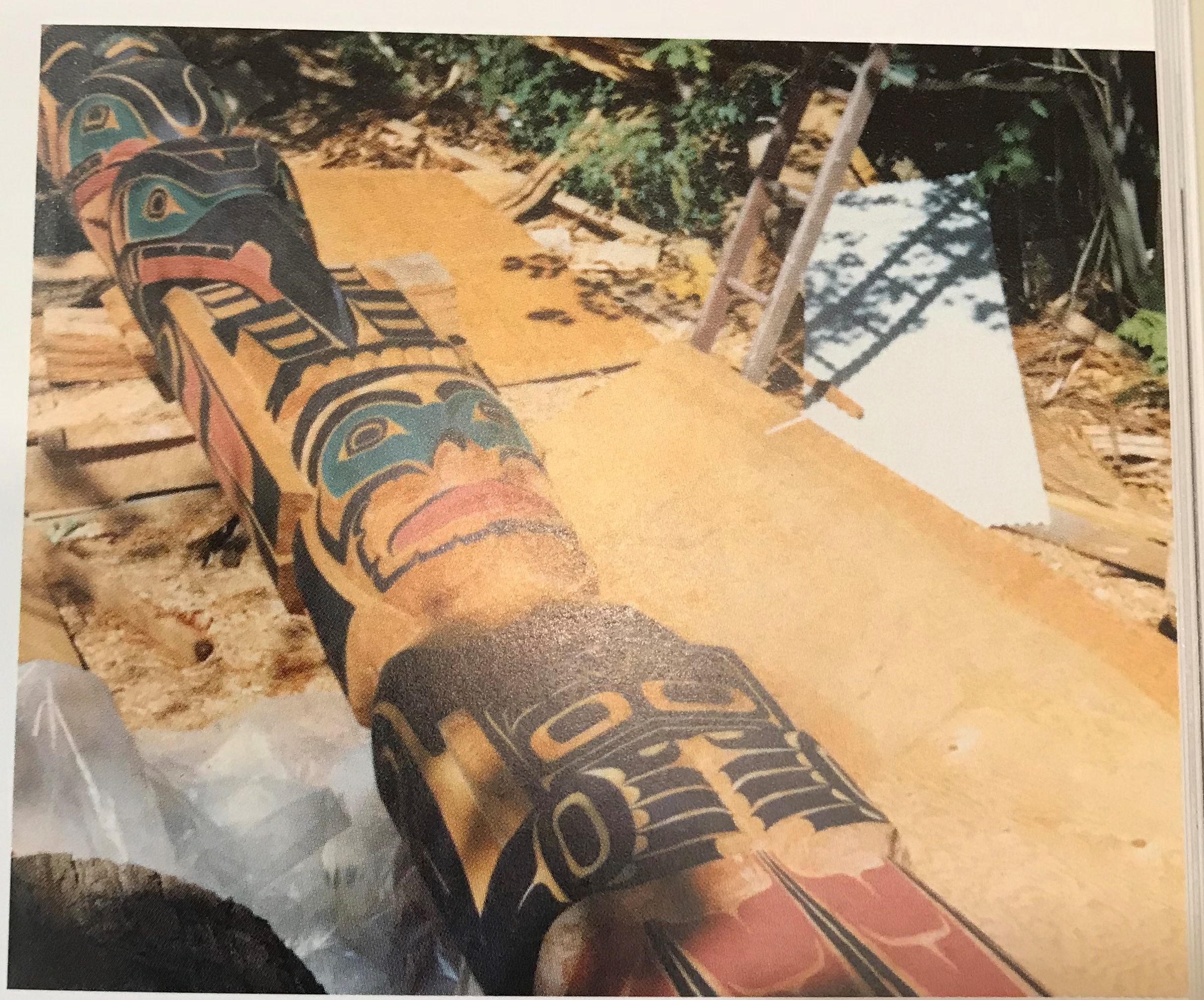Pole Figures
These descriptions are adapted from those provided by the ‘Namgis visitors Kevin Cranmer, Bruce Alfred and Chief Bill Cranmer in 2018 for an episode of Antiques Roadshow. Though many of the stories and figures on totem poles have sacred meaning for Kwakwaka’wakw peoples and are kept private, the poles which Doug Cranmer erected in foreign places such as Salford are meant to speak directly to audiences in those countries and it is appropriate in this context for them to be explained.
The bottom figure is a ‘Namgis chieftain, his face rendered in Kwakwaka’wakw foemline and painted in traditional colours of black, red and green, with white eyes. He clutches in both hands a copper. Coppers are large shield-shaped objects made from hammered copper. They represented the greatest wealth a Kwakwaka’wakw chieftain could own, and were treated as having independent lives, with names and biographies.
When a chieftain hosted a potlatch feast, the height of the Kwakwaka’wakw ceremonial calendar, he would distribute gifts to all of his guests. The most important would receive a copper from the host to take away with them. This act of generosity, transferring wealth to an ally or rival, meant that the recipient was then under an obligation to the host, and was required to repay the gift with interest at a future potlatch. This exchange was the foundation of Native political and economic structure. Between 1884 and 1951, the Canadian government made the potlatch illegal, and imprisoned those who practiced it.
The second figure is Raven. Raven is central to cosmology and legend all along the Northwest Coast -trickster figure, Raven is notorious for pulling jokes and pranks on people, some of them violent or mean-spirited, others as a form of natural justice. One of the most important concerns the theft of the Sun, Raven stealing it from a miserly old man and releasing it into the sky.
The Raven is also the crest of the Raven clan, one of the most important Kwakwaka’wakw clans. Clans are a form of loose trading confederacy, linked through ceremony and family ties, usually passed down through maternal uncles. Membership of a clan was an important part of involvement in Indigenous trade networks; it marked a trader as well-connected and accountable, a badge of authority which routinely crossed band and tribal boundaries
The third figure and the largest on the pole is the killer whale. Killer whales are the apex predators of the Northwest Coast. In a region in which sea links have always been more important than those by land, the killer whale presents a significant threat to a canoe, and were treated with reverence and fear right along the Coast. Killer whales consequently feature very heavily in Northwest Coast formline art. This example has a protruding dorsal fin, made from a separate piece of wood. At the base of its head, a masked face with pursed lips, forming the blowhole of the whale.
On the tail of the whale, which is curled across its back, is another face. This face, upside down to those facing the pole, is the subject of some debate, but may be a bear. Bears and killer whales are often, in Northest Coast stories, merely two facets of the same creature, capable of changing at will.
The topmost figure on the pole is a thunderbird. The thunderbird is a creature found in cosmology across North America, but on the Northwest Coast it stands as the most powerful being of the region. Taking the form of giantic eagle, awoken from mountain tops in thunderstorms and capable for snatching whales from the sea in its talons, the thunderbird features in many creation stories of the Northwest Coast. The ‘Namgis are said to be directly descended from one such creature.
This thunderbird demonstrates common features of many thunderbirds in Kwakwaka’wakw art; it has a yellow face and claws and, when fully assembled, features broad outstretched wings. These are a uniquely Kwakwaka’wakw feature; no other tribe creates totem poles with attached wings in this manner, and as a design they are often attributed to Charlie James, whose work in the early twentieth century was critical to the survival of Kwakwaka’wakw art in the face of the sustained and aggressive campaign of suppression by the Canadian government.
